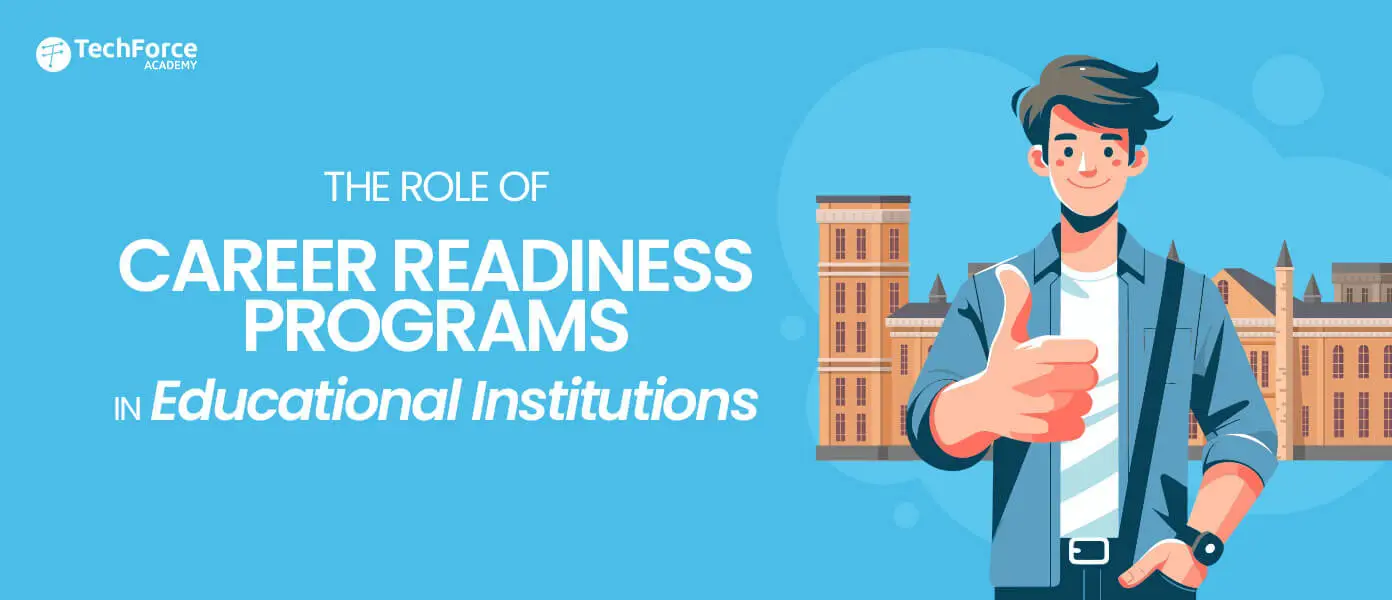In today’s job market, being skilled isn’t always enough to secure a dream job. Educational institutions play a critical role in making students ready for certain jobs via career readiness programs. These programs are built around a curriculum that aims at preparing novices with the abilities and expertise necessary to develop and do well in their selected fields.
With students in their educational way, providing them with some quality employability skills, such as good communication, teamwork, and problem-solving is important. Therefore, understanding the importance and effect of these employment and career readiness initiatives is important in securing students’ success in the ever-changing professional landscape.
Now, Let’s explore the importance of these programs and how they maximise benefits for students and the institutions involved.
What is Career Readiness?
Career readiness programs are complete and thorough initiatives designed to prepare students for the change from education to employment. They aim to bridge the gap between instructional learning and real-world workplace expectancies.
By providing career readiness skills and industry insights, these programs deliver strength to students to achieve their chosen professional paths.
The Evolution of Career Education
Over the decades, vocational training has been a part of career education. It has changed its approach from vocational education to a complete approach which integrates technology, internships, and practical learning experiences.
Career education has advanced over long ages and has witnessed a major shift from traditional vocational training to a holistic approach that accommodates technological advancements and real-world experiences.
Career education today has immensely exceeded the classroom instructions which are kept into practice through internships, apprenticeships and projects that help you to obtain practical skills and insights from the industry.
This modern approach recognises the dynamic nature of the personnel and lets newcomers go out into the workplace prepared with the proper understanding and skills necessary to cope successfully with all challenges and tasks of the 21st-century job market.
Technology’s impact on industries and its capability to generate new prospects is not a novelty to many of us. However, vocational education is the cardinal point in your empowerment because then you will be able to position yourself in a wider job market.
Importance of Career Readiness Programs
1. Economic Benefits
- Implementing career readiness programs contributes to local economies.
- These programs provide businesses with a skilled workforce.
- They help in reducing unemployment rates.
- Graduates’ earning potential increases, fostering economic growth.
2. Benefits to Students
- Career readiness programs offer students insights into career options.
- They facilitate the development of industry-specific skills.
- Students gain confidence in their professional abilities through these programs.
Key Components of Career Readiness Programs

1. Academic Preparation
- Career readiness programs give importance to academic preparation to bridge the gap between theoretical knowledge and career readiness skills.
- By customising the curriculum to meet industry demands, you not only gain knowledge but also develop adaptability which is extremely important for your success in the workforce.
2. Real-World Application
- After gaining experience through career readiness programs, you get the chance to apply academic knowledge into action through internships and workshops.
- These experiences help sharpen your skills and showcase your abilities to future employers, giving you a chance to shine in the professional world.
3. Soft Skills Development
- Career readiness programs give strong importance to soft skills development which includes communication, teamwork, and leadership.
- By learning these necessary skills, you get prepared to go through professional environments and do well in different career paths.
- This focus on career preparedness ensures that you are not only technically skilled but also have the interpersonal abilities necessary for growing in today’s workforce.
Implementing Programs in Educational Institutions
1. Partnership with Industries
- When educational institutions team up with industry leaders, they design their programs to match what the workforce is looking for. So that you are not only prepared for the workforce – you are armed with the most in-demand skills that the workforce looks.
- These partnerships open doors to new connections and offer firsthand glimpses into the world you’re stepping into.
Take, for example, Torrens University Australia and TechForce Services, who teamed up to develop talent in the business and technology sectors. As part of TechForce Services’ experiential learning effort, the TechForce Academy will provide Torrens University students pursuing business technology degrees with internships, mentorship programs, and industry-relevant projects.
2. Teacher and Staff Training
- Teachers should stay updated on new technologies, and industry standards to prepare students for the workforce.
- By investing in teacher training programs, educational institutions can make sure that their staff are prepared with the necessary knowledge and skills.
3. Continuous Program Evaluation
- By regularly assessing program outcomes, educational institutions can find areas for improvement and make necessary changes to better prepare you for employment.
- Continuous program evaluation also allows institutions to stay responsive to changing industry trends and workforce demands.
Challenges Faced by Educational Institutions in Implementing Career Readiness Programs
1. Lack of Resources and Funding
Enough resources and funding are necessary for the successful implementation of career readiness programs in educational institutions. Many institutions face financial challenges that limit the resources available for these initiatives.
This lack of funding can affect the scope and quality of education provided to students, preventing them from getting the skills necessary to prepare for future career opportunities.
2. Resistance to Change in Traditional Academic Structures
Educational institutions mostly face resistance to change when applying for career readiness programs alongside traditional education. Balancing the curriculum between traditional education and career-focused education can be challenging.
Educators try very hard to give students a complete education that prepares them for success in their future careers.
Strategies to Overcome Challenges and Enhance Career Readiness Programs
>> Leveraging Technology for Virtual Internships
With the help of digital platforms and communication tools, educational institutions open doors to virtual internships that offer more than just learning. These internships give meaningful learning experiences and connections to industry professionals.
>> Building Strong Partnerships with Businesses
By collaborating closely with businesses, educational institutions can gain valuable insights into industry trends and workforce needs. These partnerships make sure you are not just ready for the workforce, but ahead of the curve, with skills and knowledge that match what’s happening in the real world.
Measuring the Effectiveness of Career Readiness Programs
-->> Tracking Employment Rates of Program Participants
Educational institutions track of how many graduates get jobs to see if their programs are good at preparing students for work. This information tells them if the program is doing well and where they can make it better for students and employers.
-->> Surveys and Feedback Mechanisms from Employers
Institutions gather feedback from employers hiring graduates to understand how well-prepared students are for the workforce demands. Employers’ feedback on graduates’ skills guides educational institutions in identifying program strengths and areas for improvement to better meet industry needs.
This feedback loop ensures that career-ready programs remain relevant and responsive to the needs of employers and students alike.
Future Trends in Career Readiness
1. Technological Advancements
It’s important to keep up with new technology. Adding the latest tech to what students learn helps them get ready for work. Educational institutions can include innovations such as artificial intelligence, virtual reality, and data analytics. This keeps their programs useful and competitive in the changing job market.
2. Expanding Industry Collaborations
Expanding partnerships with a diverse range of industries and companies is critical for improving the effectiveness of career readiness programs. When educational institutions partner with employers from different fields, it gives you more chances and resources.
These partnerships offer invaluable insights into industry trends, networking opportunities, and real-world experiences. preparing you for successful careers in your chosen fields.
3. Integration of Soft Skills Training
The integration of soft skills training is necessary for the future of career readiness programs. Employers like skills such as communication, teamwork, and adaptability. By including soft skills training in the curriculum, educational institutions make sure that you are well-rounded and prepared to grow in different professional environments.
This integration develops necessary skills that are important for success in the modern workforce.
The Role of Professional Services Organisations in Supporting Career Readiness Programs
>> Providing Resources and Expertise
Professional organisations like TechForce Academy play an important role in supporting career readiness programs. They provide valuable resources and expertise to educational institutions.
These organisations offer access to a wide range of resources, including training materials, industry insights, and best practices. By using their expertise, institutions improve the quality of programs and prepare you for success in the workforce.
>> Facilitating Collaboration between Academia and Industry
Professional services organisations play an important role in connecting academia and industry to support career readiness programs. They act as intermediaries, linking educational institutions with businesses and industry experts.
Through partnerships and collaborative efforts, these organisations help you gain practical experience and networking opportunities, bridging the gap between theory and practice. This collaboration enhances career development programs and prepares graduates for the job market.
Conclusion
Career readiness programs are necessary to prepare you for success in today’s changing job market. Educational institutions make the future workforce by giving you the necessary career-ready skills, knowledge, and experiences to grow in your chosen careers. By giving importance to these career readiness initiatives, institutions give you the power to go through the problems of the modern workplace with confidence and competence.
As the landscape of work continues to develop, the importance of career readiness programs in ensuring the employability and success of individuals remains important.











